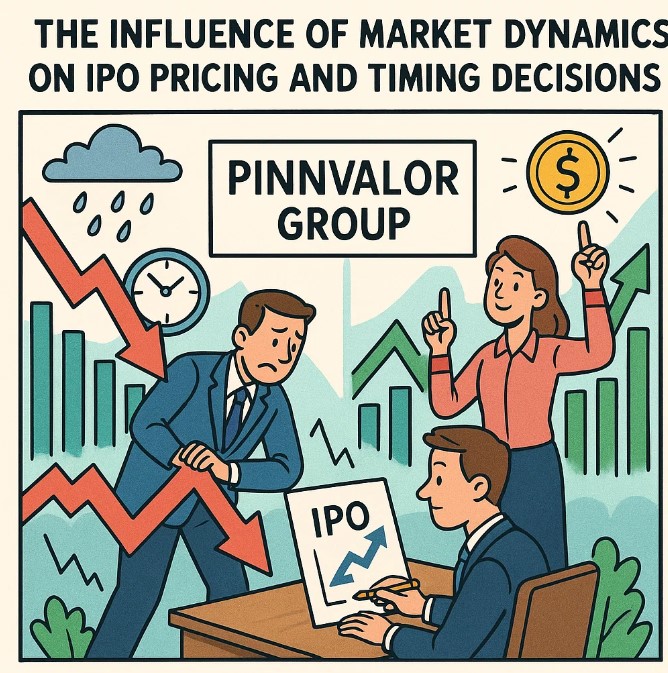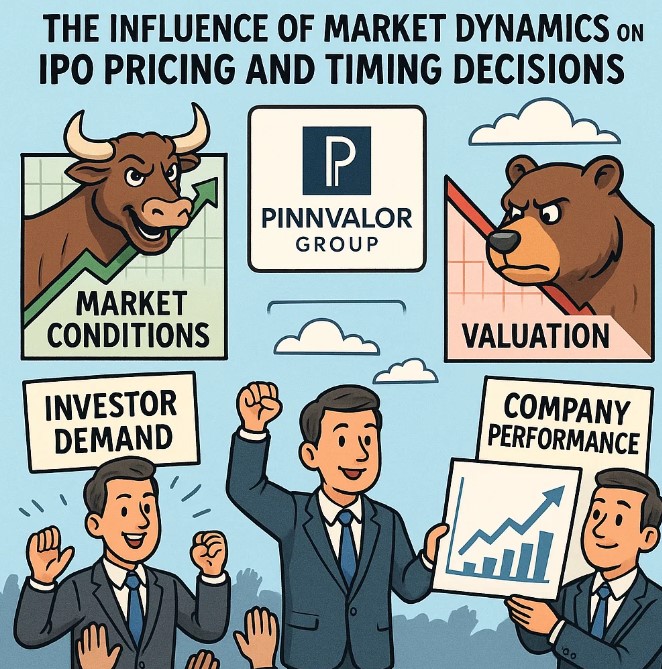
The Influence of Market Dynamics on IPO Pricing and Timing Decisions
Initial Public Offerings (IPOs) mark a pivotal moment for any company, symbolizing its transition from private to public ownership. While operational readiness and financial health are fundamental prerequisites for a successful IPO, external factors—particularly market dynamics—play an equally crucial role in shaping the pricing and timing decisions of an IPO.
In this blog, we delve deep into how market forces influence when a company goes public and how much it can expect to raise through its share price.
Can the pulse of the market really determine the fate of your IPO?
Market dynamics don’t just influence IPOs—they define them. Understanding sentiment, trends, and timing can be the difference between a blockbuster debut and a quiet flop.
1. Understanding IPO Pricing and Timing
Before diving into market dynamics, it’s essential to understand the two core aspects of IPO decision-making:
- IPO Pricing: Refers to the price per share at which the company offers its stock to the public.
- IPO Timing: Involves selecting the optimal moment to enter the public market, which can significantly impact valuation and investor sentiment.
Both these elements are deeply influenced by external market conditions, making timing and pricing as much art as science.
2. Key Market Dynamics That Influence IPO Decisions
A. Market Sentiment
Market sentiment reflects the overall attitude of investors toward financial markets.
- Bull Markets: In a bullish environment, investors are optimistic, liquidity is high, and there’s a stronger appetite for risk. This allows companies to price their shares higher and still attract investor interest.
- Bear Markets: In contrast, bearish conditions lead to caution. Even fundamentally strong companies may have to lower IPO prices or postpone listings to avoid poor reception.
Example: Many tech companies delayed their IPOs in early 2022 due to market volatility, fearing lower valuations amid tightening monetary policy and geopolitical tensions.
B. Industry Trends
The performance and outlook of a company’s industry significantly impact its IPO prospects.
- Companies in trending sectors (e.g., AI, green energy, fintech) can command premium valuations.
- Conversely, if an industry is under scrutiny or in decline (e.g., fossil fuels, traditional retail), IPOs from those sectors may suffer poor demand or reduced pricing.
Example: During the COVID-19 pandemic, healthcare and biotech IPOs boomed due to high investor interest in vaccine and treatment development.
C. Interest Rates and Monetary Policy
Central bank policies heavily influence investor behavior.
- Low interest rates generally push investors toward equities for better returns, increasing demand for IPOs.
- High interest rates make fixed-income assets more attractive, reducing the relative appeal of stocks, which can suppress IPO valuations.
Insight: The U.S. Federal Reserve’s interest rate hikes in 2022 and 2023 led to a notable decline in IPO activity, especially in high-growth sectors.
D. Economic Indicators
Macroeconomic indicators such as GDP growth, inflation, employment rates, and consumer confidence affect IPO markets.
- Positive indicators boost investor confidence, enabling stronger IPO pricing and better timing.
- Negative indicators lead to increased market uncertainty, which can deter companies from going public.
E. Peer Performance and Comparable IPOs
The performance of recent IPOs—especially those in similar industries—serves as a benchmark.
- A string of successful IPOs builds investor confidence and often allows new issuers to price shares at a premium.
- On the other hand, underperforming IPOs may signal overvaluation concerns, prompting companies to revise or delay their plans.
Example: The success of Rivian’s IPO in 2021 temporarily boosted investor sentiment toward electric vehicle startups.

3. IPO Windows: Timing is Everything
The term “IPO window” refers to a favorable period when market conditions support successful public offerings. These windows open and close based on investor appetite and broader market movements.
Companies often engage in “window shopping”—waiting and watching the market before launching their IPOs to ensure they capitalize on the best timing.
4. Strategies Companies Use in Response to Market Dynamics
A. Flexible Pricing Models
- Many companies use book-building to gauge investor demand before finalizing the IPO price.
- Price bands allow underwriters to adjust pricing based on real-time feedback from institutional investors.
B. Confidential Filings and Delays
- Companies may opt for confidential IPO filings to explore market conditions without public commitment.
- IPOs can be shelved or delayed without much reputational damage if markets deteriorate.
C. Cornerstone Investors
- Attracting anchor or cornerstone investors helps bolster market confidence and signal quality to the broader investing community.
5. Case Studies: Lessons from the Market
Case 1: Airbnb (2020)
Originally delayed due to the pandemic, Airbnb re-entered IPO preparations when market sentiment turned bullish. Strong demand and market optimism allowed it to price at $68 per share—above the initial range—and surge 112% on the first day.
Case 2: WeWork (2019)
Initially targeting a high valuation, WeWork’s IPO collapsed amid scrutiny over its governance and business model. Market feedback and negative sentiment forced a dramatic valuation cut and eventual withdrawal of the IPO.
6. Conclusion: Market Dynamics as a Double-Edged Sword
Market dynamics are an unavoidable and powerful force in IPO planning. While favorable conditions can unlock maximum value, adverse environments can jeopardize even the most promising listings. Companies need to stay agile, work closely with advisors, and maintain a robust understanding of macroeconomic trends to ensure they make the most of their IPO journey.
Final Thought:
In the end, IPO success is not just about a company’s internal strengths—it’s also about playing the market’s rhythm with precision and prudence.
